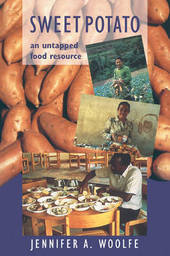
|
Sweet Potato: An Untapped Food Resource
Paperback / softback
Main Details
| Title |
Sweet Potato: An Untapped Food Resource
|
| Authors and Contributors |
By (author) Jennifer A. Woolfe
|
| Physical Properties |
| Format:Paperback / softback | | Pages:660 | | Dimensions(mm): Height 228,Width 151 |
|
| Category/Genre | Botany and plant sciences
Agronomy and crop production
Growing fruit and vegetables |
|---|
| ISBN/Barcode |
9780521050531
|
| Classifications | Dewey:635.2 |
|---|
| Audience | | Professional & Vocational | |
|---|
|
Publishing Details |
| Publisher |
Cambridge University Press
|
| Imprint |
Cambridge University Press
|
| Publication Date |
21 January 2008 |
| Publication Country |
United Kingdom
|
Description
The sweet potato is at present grown in more than 100 of the independent countries of the world. Most of the producer nations are situated in the tropical developing world where a high proportion of the poorest people live. Increasing recognition of the potential which sweet potato holds for combating food shortages and malnutrition has resulted in intensified research efforts to enhance production and consumption. This book reviews our knowledge about the varied aspects of the sweet potato as a human food and animal feedstuff. This volume will be found practical and informative by all those involved in food and nutrition sciences, especially but not exclusively in developing countries. These include research workers in food or agriculture, dieticians, nutritionists, food technologists, students, planners and policy makers.
Reviews"...the author presents a good case for increasing consumption of this vegetable. The book is a comprehensive coverage of the subject, written in a pleasant style that is easily read...an attractive, well-organized book with an assortment of interesting photographs." Jimmie L. Collins, Food Technology "...quite valuable to a wide audience, including food and agricultural policymakers, dieticians, extension workers, and agronomists." Judith Fey Thomas, Science Books & Films "...no student of roots and tubers should be without this book." New Biological Books
|